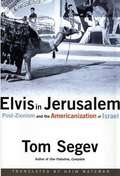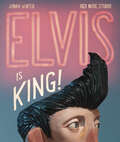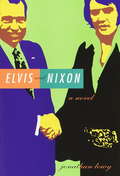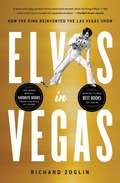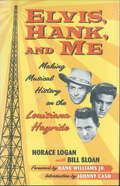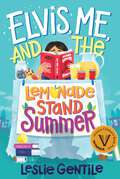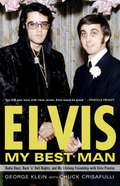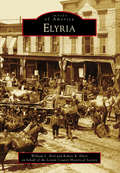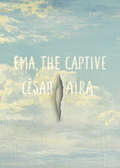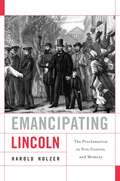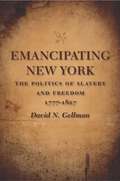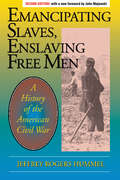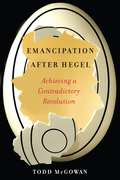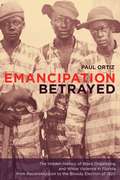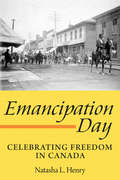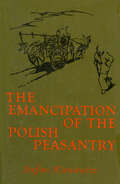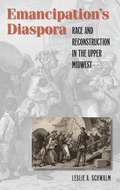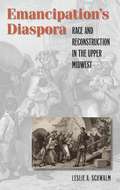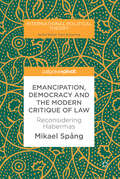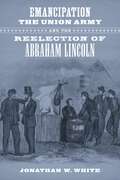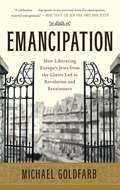- Table View
- List View
Elvis In Jerusalem: Post-Modernism and the Americanization of Israel
by Haim Watzman Tom SegevAs the Middle East conflict enters its most violent phase, Tom Segev offers a lively, contentious polemic against cherished and rigid notions of Israel's national unity and culture. In his many works of history, Tom Segev has challenged the entrenched understanding of crucial moments in Israel's past. Now, in a short, sharp, polemical book, Segev has turned his sights from Israeli history to confront some revered assumptions about the country today.Drawing on personal experience as well as all kinds of artifacts from Israeli popular culture -- shopping malls, fast food, public art, television, religious kitsch -- Segev offers a controversial point of view: the sweeping Americanization of the country, rued by most, has had an extraordinarily beneficial influence, bringing not only McDonald's and Dunkin' Donuts but the virtues of pragmatism, tolerance, and individualism.
Elvis Is Everywhere
by Rowland SchermanElvis, it seems, is everywhere. And for about three years, Rowland Scherman went looking for him. Elvis Is Everywhere captures this pursuit, in 70 photos documenting the author's travels to Boston, Los Angeles, Nashville, Venice Beach, Orlando, Nag’s Head, Cape Cod, New York, Pasadena, and, of course, Memphis. In all these places was evidence that Elvis lives, at least in spirit, long after his well-mourned death. This book is not so much about Elvis as it is about us. The abiding loyalty and reverence of the King’s devoted fans have enabled him to transcend even the most outrageous promotional hype. His image and his name have been absorbed into the language, the landscape, our very culture. Elvis continues to cast his spell on our collective consciousness.
Elvis Is King!
by Jonah WinterElvis Presley--the King of Rock 'n' Roll, still beloved by millions of Americans--comes to vibrant, gyrating life in this extraordinary picture-book biography from an award-winning author and the winner of a New York Times Best Illustrated Book Award.Here's the perfect book for anyone who wants to introduce rock 'n' roll and its king to the child in their lives. In single- page "chapters" with titles like "The First Cheeseburger Ever Eaten by Elvis" and "Shazam! A Blond Boy Turns into a Black-Haired Teenager," readers can follow key moments in Presley's life, from his birth on the wrong side of the railroad tracks in the Deep South, to playing his first guitar in grade school, to being so nervous during a performance as a teenager that he starts shaking . . . and changes the world!Jonah Winter and Red Nose Studio have created a tour-de-force that captures a boy's loneliness and longing, along with the energy and excitement, passion, and raw talent that was Elvis Presley."Readers will want to pore over this thoroughly engaging volume." -- Kirkus Reviews, starred review
Elvis and Nixon
by Jonathan LowyA darkly comic, fictional trip through 1970s Americana with Richard Nixon and Elvis Presley riding shotgun. On December 21st, 1970 a drug-addled Elvis Presley showed up unannounced at the entrance gate of the White House with a handwritten request to meet with President Nixon. Elvis lamented the Beatles as a "real force for anti-American spirit" and assured the commander-in-chief, "I'm on your side." With aides watching and flashbulbs popping, Nixon presented Elvis with an FBI Special Narcotics Agent badge; an ecstatic Elvis put his arms around the President, pulling him in for a spontaneous embrace. It was a surreal - yet undeniably real - moment in history. But the stranger-than-fiction story doesn't end, or begin, there... Against the backdrop of that historical meeting, Jonathan Lowy weaves a vivid web of stories about the eccentric cast of characters whose lives were forever changed by the encounter. Some of the stories are fact, some are fiction, but all are unforgettable. We meet a colonel, who spends his tormented days at the Pentagon trying to develop the right PR spin on the My Lai massacre; an eager-beaver policy wonk, who cooks up feel-good White House programs to distract the public from the war; and a disabled black veteran, whose act of protest in a Rose Garden ceremony sets off a spectacular chain of events. In the middle of the fray stand Richard Nixon - his integrity and presidency becoming more precarious by the day - and Elvis Presley - desperately searching for what he's lost along the way to stardom. Impossible to put down and peopled with a memorable cast of characters, Elvis and Nixon is a sleek, incisive exploration of America at a crucial tipping point.
Elvis in Vegas: How the King Reinvented the Las Vegas Show
by Richard ZoglinThe story of how Las Vegas saved Elvis and Elvis saved Las Vegas in the greatest musical comeback of all time.The conventional wisdom is that Las Vegas is what destroyed Elvis Presley, launching him on a downward spiral of drugs, boredom, erratic stage behavior, and eventually his fatal overdose. But in Elvis in Vegas, Richard Zoglin takes an alternate view, arguing that Vegas is where the King of Rock and Roll resurrected his career, reinvented himself as a performer, and created the most exciting show in Vegas history. Elvis’s 1969 opening night in Vegas was his first time back on a live stage in more than eight years. His career had gone sour—bad movies, and mediocre pop songs that no longer made the charts. He’d been dismissed by most critics as over the hill. But in Vegas he played the biggest showroom in the biggest hotel in the city, drawing more people for his four-week engagement than any other show in Vegas history. His performance got rave reviews, “Suspicious Minds” gave him his first number-one hit in seven years, and Elvis became Vegas’s biggest star. Over the next seven years, he performed more than 600 shows there, and sold out every one. Las Vegas was changed too. The intimate night-club-style shows of the Rat Pack, who made Vegas the nation’s premier live-entertainment center in the 1950s and ‘60s, catered largely to well-heeled older gamblers. Elvis brought a new kind of experience: an over-the-top, rock-concert-like extravaganza. He set a new bar for Vegas performers, with the biggest salary, the biggest musical production, and the biggest promotion campaign the city had ever seen. In doing so, he opened the door to a new generation of pop/rock performers, and brought a new audience to Vegas—a mass audience from Middle America that Vegas depends on for its success to this day. A classic comeback tale set against the backdrop of Las Vegas’s golden age, Richard Zoglin’s Elvis in Vegas is a feel-good story for the ages.
Elvis, Hank, and Me: Making Musical History on the Louisiana Hayride
by Bill Sloan Horace LoganIn 1948, Horace "Hoss" Logan, a young radio producer in Shreveport, Louisiana, started booking talent for a new weekly music show called the Louisiana Hayride. Performed for a live audience and broadcast nationally over the CBS Radio network, the show became known as the "Cradle of the Stars." In this affectionate memoir, Hoss Logan recalls the Hayride's heyday with behind-the-scenes anecdotes about the dozens of musicians he knew and nurtured, including Johnny Cash, Johnny Horton, George Jones, Willie Nelson, Elvis Presley, Jim Reeves, Kitty Wells, Slim Whitman, Hank Williams, Faron Young, and many more. As producer, emcee, and friend to the Hayride performers, Logan gives us a personal look into musical history - from Hank Williams's ups and downs to the teenage Elvis's first performance on national radio to the ways the Hayride's many emerging stars expanded our idea about what country music could be.
Elvis, Me, and the Lemonade Stand Summer
by Leslie GentileWinner of the 2021 City of Victoria Children’s Book Prize It’s the summer of 1978 and most people think Elvis Presley has been dead for a year. But not eleven-year-old Truly Bateman – because she knows Elvis is alive and well and living in the Eagle Shores Trailer Park. Maybe no one ever thought to look for him at on the Eagle Shores First Nation on Vancouver Island. It’s a busy summer for Truly. Though her mother is less of a mother than she ought to be, and spends her time drinking and smoking and working her way through new boyfriends, Truly is determined to raise as much money for herself as she can through her lemonade stand … and to prove that her cool new neighbour is the one and only King of Rock ‘n’ Roll. And when she can’t find motherly support in her own home, she finds sanctuary with Andy El, the Salish woman who runs the trailer park.
Elvis, Me, and the Lemonade Stand Summer
by Leslie GentileWinner of the 2021 City of Victoria Children’s Book Prize It’s the summer of 1978 and most people think Elvis Presley has been dead for a year. But not eleven-year-old Truly Bateman – because she knows Elvis is alive and well and living in the Eagle Shores Trailer Park. Maybe no one ever thought to look for him at on the Eagle Shores First Nation on Vancouver Island. It’s a busy summer for Truly. Though her mother is less of a mother than she ought to be, and spends her time drinking and smoking and working her way through new boyfriends, Truly is determined to raise as much money for herself as she can through her lemonade stand … and to prove that her cool new neighbour is the one and only King of Rock ‘n’ Roll. And when she can’t find motherly support in her own home, she finds sanctuary with Andy El, the Salish woman who runs the trailer park.
Elvis: My Best Man
by George Klein Chuck CrisafulliWhen George Klein was thirteen, he couldn't have known how important the new kid in class u the one with the guitar, the boy named Elvis u would become in his life. But from the first time GK (as he was nicknamed by Elvis) heard this kid sing, he knew that Elvis Presley was someone extraordinary. In this heartfelt, entertaining and affectionate memoir, George Klein writes candidly about their close friendship, which began at school and continued through Elvis's rise to fame and the wild swirl of his tumultuous life, right up to the singer's tragic death. Writing with the authority of someone who was in the midst of it all, from the good times at Graceland and hanging out with Hollywood stars to butting heads with Elvis's iron-handed manager, Colonel Tom Parker, GK reveals who the King really was and how he acted when the stage lights were off. Full of anecdotes and first-hand accounts of some of the most defining moments in the legend's life, Elvis: My Best Man captures the true essence of the man behind the music.
Elvis’s Army
by Brian Mcallister LinnWhen the Army drafted Elvis in 1958, it set about transforming the King of Rock and Roll from a rebellious teen idol into a clean-cut GI trained for nuclear warfare. Brian Linn traces the origins, evolution, and ultimate failure of the army's attempt to reinvent itself for the Atomic Age, and reveals the experiences of its forgotten soldiers.
Elyria
by Robert R. Ebert Lorain County Historical Society William L. BirdElyria is named for Heman Ely, who in 1817 settled in a strategically located area close to Lake Erie along the picturesque Black River. Historically, Elyria, which became the seat of Lorain County, has been a center of commerce and government while also serving as a market and source of supplies for the surrounding agricultural community. Industrial development has included steel mills, quarries, automobile-related firms, and a wide variety of other manufacturing facilities. Over the years, Broad Street has been an important center of retail and professional activity. For recreation, Elyria's citizens are able to enjoy beautiful parks and recreation facilities.
Em Busca do Meu Malandro
by Beatriz Garcia Dawn BrowerA irmã de Alys Dewitt estava se casando. Para sua sorte, ela seria a madrinha do casamento onde o tema era a época da Regência, que teria como cenário um ducado de verdade no interior da Inglaterra. Enquanto está na festa de casamento, ela cai e viaja no tempo, acordando em 1815. Tudo era estranho, assombroso, e nada do que ela esperada que fosse. James Kendall, O Duque de Weston, retorna da guerra e encontra uma mulher machucada em sua propriedade. Ela murmura frases estranhas e o chamar por outro nome. Achando que ela estava louca por causa de seus ferimentos, ele a leva para a mansão e chama um médico. Eles sucumbirão aos desejos mútuos, ou Alys acharia um jeito de voltar para seu próprio tempo?
Ema the Captive
by César Aira Chris AndrewsEma The Captive, César Aira's second novel, is perhaps closest in style to his popular An Episode in the Life of a Landscape Painter and The Hare In nineteenth-century Argentina, Ema, a delicate woman of indeterminate origins, is captured by soldiers and taken, along with with her newborn babe, to live as a concubine in a crude fort on the very edges of civilization. The trip is appalling (deprivations and rapes prevail along the way), yet the real story commences once Ema arrives at the fort, where she takes on a succession of lovers among the soldiers and Indians, leading to a brave and grand entrepreneurial experiment. As is usual with Aira's work, the wonder of the book is in the details of customs, beauty, and language, and the curious, perplexing reality of human nature.
Emancipating Lincoln
by Harold HolzerEmancipating Lincoln seeks a new approach to the Emancipation Proclamation, a foundational text of American liberty that in recent years has been subject to woeful misinterpretation. These seventeen hundred words are Lincoln's most important piece of writing, responsible both for his being hailed as the Great Emancipator and for his being pilloried by those who consider his once-radical effort at emancipation insufficient and half-hearted. Harold Holzer, an award-winning Lincoln scholar, invites us to examine the impact of Lincoln’s momentous announcement at the moment of its creation, and then as its meaning has changed over time. Using neglected original sources, Holzer uncovers Lincoln’s very modern manipulation of the media-from his promulgation of disinformation to the ways he variously withheld, leaked, and promoted the Proclamation-in order to make his society-altering announcement palatable to America. Examining his agonizing revisions, we learn why a peerless prose writer executed what he regarded as his “greatest act” in leaden language. Turning from word to image, we see the complex responses in American sculpture, painting, and illustration across the past century and a half, as artists sought to criticize, lionize, and profit from Lincoln’s endeavor. Holzer shows the faults in applying our own standards to Lincoln’s efforts, but also demonstrates how Lincoln’s obfuscations made it nearly impossible to discern his true motives. As we approach the 150th anniversary of the Proclamation, this concise volume is a vivid depiction of the painfully slow march of all Americans-white and black, leaders and constituents-toward freedom.
Emancipating New York: The Politics of Slavery and Freedom, 1777–1827 (Antislavery, Abolition, and the Atlantic World)
by David N. GellmanAn innovative blend of cultural and political history, Emancipating New York is the most complete study to date of the abolition of slavery in New York state. Focusing on public opinion, David N. Gellman shows New Yorkers engaged in vigorous debates and determined activism during the final decades of the eighteenth century as they grappled with the possibility of freeing the state's black population. The gradual emancipation that began in New York in 1799 helped move an entire region of the country toward a historically rare slaveless democracy, creating a wedge in the United States that would ultimately lead to the Civil War. Gellman's comprehensive examination of the reasons for and timing of New York's dismantling of slavery provides a fascinating narrative of a citizenry addressing longstanding injustices central to some of the greatest traumas of American history.
Emancipating Slaves, Enslaving Free Men
by John Majewski Jeffrey HummelThis book combines a sweeping narrative of the Civil War with a bold new look at the war's significance for American society. Professor Hummel sees the Civil War as America's turning point: simultaneously the culmination and repudiation of the American revolution. While the chapters tell the story of the Civil War and discuss the issues raised in readable prose, each chapter is followed by a detailed bibliographical essay, looking at all the different major works on the subject, with their varying ideological viewpoints and conclusions. In his economic analysis of slavery, Professor Hummel takes a different view than the two major poles which have determined past discussions of the topic. While some writers claim that slavery was unprofitable and harmful to the Southern economy, and others maintain it was profitable and efficient for the South, Hummel uses the economic concept of Deadweight Loss to show that slavery was both highly profitable for slave owners and harmful to Southern economic development. While highly critical of Confederate policy, Hummel argues that the war was fought to prevent secession, not to end slavery, and that preservation of the Union was not necessary to end slavery: the North could have let the South secede peacefully, and slavery would still have been quickly terminated. Part of Hummel's argument is that the South crucially relied on the Northern states to return runaway slaves to their owners. This new edition has a substantial new introduction by the author, correcting and supplementing the account given in the first edition (the major revision is an increase in the estimate of total casualties) and a foreword by John Majewski, a rising star of Civil War studies.
Emancipation After Hegel: Achieving a Contradictory Revolution
by Todd McGowanHegel is making a comeback. After the decline of the Marxist Hegelianism that dominated the twentieth century, leading thinkers are rediscovering Hegel’s thought as a resource for contemporary politics. What does a notoriously difficult nineteenth-century German philosopher have to offer the present? How should we understand Hegel, and what does understanding Hegel teach us about confronting our most urgent challenges?In this book, Todd McGowan offers us a Hegel for the twenty-first century. Simultaneously an introduction to Hegel and a fundamental reimagining of Hegel’s project, Emancipation After Hegel presents a radical Hegel who speaks to a world overwhelmed by right-wing populism, authoritarianism, neoliberalism, and economic inequalities. McGowan argues that the revolutionary core of Hegel’s thought is contradiction. He reveals that contradiction is inexorable and that we must attempt to sustain it rather than overcoming it or dismissing it as a logical failure. McGowan contends that Hegel’s notion of contradiction, when applied to contemporary problems, challenges any assertion of unitary identity as every identity is in tension with itself and dependent on others. An accessible and compelling reinterpretation of an often-misunderstood thinker, this book shows us a way forward to a new politics of emancipation as we reconcile ourselves to the inevitability of contradiction and find solidarity in not belonging.
Emancipation Betrayed: The Hidden History of Black Organizing and White Violence in Florida from Reconstruction to the Bloody Election of 1920 (American Crossroads #16)
by Paul OrtizIn this penetrating examination of African American politics and culture, Paul Ortiz throws a powerful light on the struggle of black Floridians to create the first statewide civil rights movement against Jim Crow. Concentrating on the period between the end of slavery and the election of 1920, Emancipation Betrayed vividly demonstrates that the decades leading up to the historic voter registration drive of 1919-20 were marked by intense battles during which African Americans struck for higher wages, took up arms to prevent lynching, forged independent political alliances, boycotted segregated streetcars, and created a democratic historical memory of the Civil War and Reconstruction. Contrary to previous claims that African Americans made few strides toward building an effective civil rights movement during this period, Ortiz documents how black Floridians formed mutual aid organizations—secret societies, women's clubs, labor unions, and churches—to bolster dignity and survival in the harsh climate of Florida, which had the highest lynching rate of any state in the union. African Americans called on these institutions to build a statewide movement to regain the right to vote after World War I. African American women played a decisive role in the campaign as they mobilized in the months leading up to the passage of the Nineteenth Amendment. The 1920 contest culminated in the bloodiest Election Day in modern American history, when white supremacists and the Ku Klux Klan violently, and with state sanction, prevented African Americans from voting. Ortiz's eloquent interpretation of the many ways that black Floridians fought to expand the meaning of freedom beyond formal equality and his broader consideration of how people resist oppression and create new social movements illuminate a strategic era of United States history and reveal how the legacy of legal segregation continues to play itself out to this day.
Emancipation Day: Celebrating Freedom in Canada
by Natasha L. HenryWhen the passage of the Abolition of Slavery Act, effective August 1, 1834, ushered in the end of slavery throughout the British Empire, people of the African descent celebrated their newfound freedom. Now African-American fugitive slaves, free black immigrants, and the few remaining enslaved Africans could live unfettered live in Canada – a reality worthy of celebration. This new, well-researched book provides insight into the creation, development, and evolution of a distinct African-Canadian tradition through descriptive historical accounts and appealing images. The social, cultural, political, and educational practices of Emanipation Day festivities across Canada are explored, with emphasis on Ontario, Nova Scotia, New Brunswick, Quebec, and British Columbia. "Emancipation is not only a word in the dictionary, but an action to liberate one’s destiny. This outstanding book is superb in the interpretation of "the power of freedom" in one’s heart and mind – moving from 1834 to present." – Dr. Henry Bishop, Black Cultural Centre, Dartmouth, Nova Scotia
Emancipation's Diaspora
by Leslie A. SchwalmMost studies of emancipation's consequences have focused on the South. Moving the discussion to the North, Leslie Schwalm enriches our understanding of the national impact of the transition from slavery to freedom. Emancipation's Diaspora follows the lives and experiences of thousands of men and women who liberated themselves from slavery, made their way to overwhelmingly white communities in Iowa, Minnesota, and Wisconsin, and worked to live in dignity as free women and men and as citizens.Schwalm explores the hotly contested politics of black enfranchisement as well as collisions over segregation, civil rights, and the more informal politics of race--including how slavery and emancipation would be remembered and commemorated. She examines how gender shaped the politics of race, and how gender relations were contested and negotiated within the black community. Based on extensive archival research, Emancipation's Diaspora shows how in churches and schools, in voting booths and Masonic temples, in bustling cities and rural crossroads, black and white Midwesterners--women and men--shaped the local and national consequences of emancipation.
Emancipation's Diaspora: Race and Reconstruction in the Upper Midwest
by Leslie A. SchwalmMost studies of emancipation's consequences have focused on the South. Moving the discussion to the North, Schwalm enriches our understanding of the national impact of the transition from slavery to freedom. Emancipation's Diaspora follows the lives and experiences of thousands of men and women who liberated themselves from slavery, made their way to overwhelmingly white communities in Iowa, Minnesota, and Wisconsin, and worked to live in dignity as free women and men and as citizens. Schwalm explores the hotly contested politics of black enfranchisement as well as collisions over segregation, civil rights, and the more informal politics of race-- including how slavery and emancipation would be remembered and commemorated. She examines how gender shaped the politics of race, and how gender relations were contested and negotiated within the black community. Based on extensive archival research,Emancipation's Diaspora shows how in churches and schools, in voting booths and Masonic temples, in bustling cities and rural crossroads, black and white Midwesterners-- women and men-- shaped the local and national consequences of emancipation.
Emancipation, Democracy and the Modern Critique of Law: Reconsidering Habermas (International Political Theory)
by Mikael SpångThis book focuses on Jürgen Habermas’ theorising on law, rights and democracy in light of the modern critique of law. The latter tradition, which goes back to Hegel and Marx, has addressed the limitations of rights as vocabulary of emancipation and law as language of autonomy. Since Habermas claims that his reconstruction of private and public autonomy has an emancipatory aim, the author has chosen to discuss it in the context of the modern critique of law. More specifically, the study addresses the need to consider the dialectic of law, in which law is both a condition for emancipation and domination, when discussing what law and rights permit. It will appeal to students and scholars across the fields of political theory, law and legal criticism, as well as sociology and sociology of law.
Emancipation, the Union Army, and the Reelection of Abraham Lincoln (Conflicting Worlds: New Dimensions of the American Civil War)
by Jonathan W. WhiteThe Union army's overwhelming vote for Abraham Lincoln's reelection in 1864 has led many Civil War scholars to conclude that the soldiers supported the Republican Party and its effort to abolish slavery. In Emancipation, the Union Army, and the Reelection of Abraham Lincoln Jonathan W. White challenges this reigning paradigm in Civil War historiography, arguing instead that the soldier vote in the presidential election of 1864 is not a reliable index of the army's ideological motivation or political sentiment. Although 78 percent of the soldiers' votes were cast for Lincoln, White contends that this was not wholly due to a political or social conversion to the Republican Party. Rather, he argues, historians have ignored mitigating factors such as voter turnout, intimidation at the polls, and how soldiers voted in nonpresidential elections in 1864.While recognizing that many soldiers changed their views on slavery and emancipation during the war, White suggests that a considerable number still rejected the Republican platform, and that many who voted for Lincoln disagreed with his views on slavery. He likewise explains that many northerners considered a vote for the Democratic ticket as treasonous and an admission of defeat.Using previously untapped court-martial records from the National Archives, as well as manuscript collections from across the country, White convincingly revises many commonly held assumptions about the Civil War era and provides a deeper understanding of the Union Army.
Emancipation: How Liberating Europe's Jews from the Ghetto Led to Revolution and Renaissance
by Michael GoldfarbThe first popular history of the emancipation of Europe's Jews in the 18th and 19th centuries.
